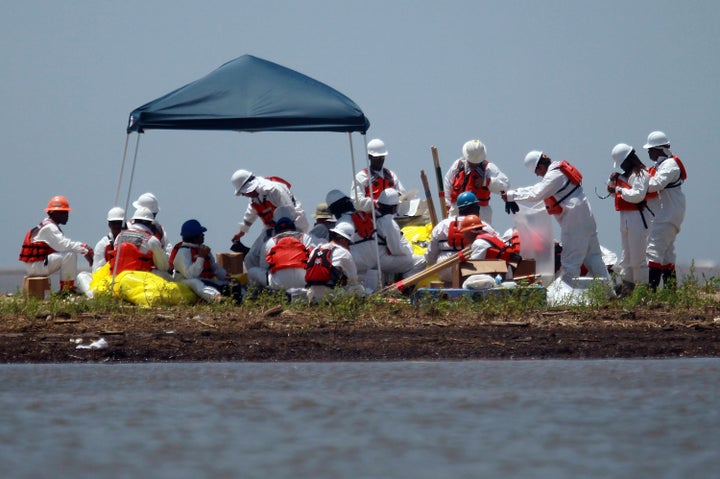
Venice, Louisiana -- Local fishermen hired to work on BP's uncontrolled oil leak in the Gulf of Mexico are scared and confused. Fishermen here and in other small communities dotting the southern marshes and swamplands of Barataria Bay are getting sick from the working on the cleanup, yet BP is assuring them they don't need respirators or other special protection from the crude oil, strong hydrocarbon vapors, or chemical dispersants being sprayed in massive quantities on the oil slick.
Fishermen have never seen the results from the air-quality monitoring patches some of them wear on their rain gear when they are out booming and skimming the giant oil slick. However, more and more fishermen are suffering from bad headaches, burning eyes, persistent coughs, sore throats, stuffy sinuses, nausea, and dizziness. They are starting to suspect that BP is not telling them the truth.
And based on air monitoring conducted by the Environmental Protection Agency (EPA) in a Louisiana coastal community, those workers seem to be correct. The EPA findings show that airborne levels of toxic chemicals like hydrogen sulfide, and volatile organic compounds like benzene, for instance, now far exceed safety standards for human exposure.
For two weeks, I've been in Louisiana, Mississippi, and Alabama sharing stories from the Exxon Valdez oil spill, which devastated the community I lived and commercially fished in, with everyone from fishermen and women to local mayors to state governors and the crush of international media.
During the 1989 cleanup in Alaska, thousands of workers had what Exxon medical doctors called, "the Valdez Crud," and dismissed as simple colds and flu. Fourteen years later, I followed the trail of sick workers through the maze of court records, congressional records, obituaries, and media stories, and made hundreds of phone calls. I found a different story. As one former cleanup worker put it, "I thought I had the Valdez Crud in 1989. I didn't think I'd have it for fourteen years."
In 1989 Exxon knew cleanup workers were getting sick: Exxon's clinical data shows 6,722 cases of upper respiratory "infections"--or more likely work-related chemical induced illnesses. Exxon also knew workers were being overexposed to oil vapors and oil particles as verified through its air-quality monitoring program contracted to Med-Tox. The cleanup workers never saw results of this program. Neither did OSHA, the agency supposedly charged to oversee and independently monitor Exxon's worker-safety program.
Alarmed by the "chemical poisoning epidemic," as expert witness Dr. Daniel Teitelbaum would later call it when he testified on behalf of sick workers, Exxon created a partial release form to indemnify itself from future health claims. Exxon paid its workers $600.50 to sign it, as I discovered in court records.
Sick workers were left to fend for themselves. Merle Savage was a foreman on the Bering Trader during the cleanup and supervised 180 workers. She described a persistent headache and "bronchitis" symptoms in 1989 that "wouldn't go away." Her medical doctors didn't connect her symptoms to her hazardous waste cleanup work. She is now completely disabled.
Richard Nagel, a master captain, supervised the workers who sprayed the dispersant Inipol. Exxon called Inipol, a "bioremediation" agent, but the Material Safety Data Sheet listed the solvent and human health hazard, 2-butoxyethanol. The U.S. Environmental Protection Agency knows the Product Schedule is rife with abuse and products are used interchangeably - and that "misuses may cause further harm to the environment than the oil alone," but the charade continues. Nagel outlived most of his crew on the Pegasus. He was fifty-three when he died in 2009 of complications from systemic illnesses that his medical doctors never connected to his cleanup work.
Unlike the Exxon Valdez tragedy, in more recent oil spills human-health studies were conducted by independent qualified personnel. After the 2002 Prestige oil spill, medical researchers reported that fishermen and residents of Galacia, Spain, suffered identical symptoms to Exxon Valdez and now BP Gulf responders when cleaning up off their coast - or just from breathing air laced with oil vapors, driven by hurricane force winds. Similarly, after the 2007 Hebei Spirit oil spill off the coast of Taean, South Korea, medical researchers documented respiratory damage, central nervous system damage, and even genetic damage in volunteers and fishermen who worked on the cleanup.
There is no excuse for sick people. BP and the federal agencies charged with worker safety know that the risks of working on a hazardous waste cleanup are extraordinarily high and that it will take a concerted effort to keep workers safe and healthy. Further, it will take an equally extraordinary effort by BP and the federal government to protect public health in coastal communities downwind or downstream from the toxic stew in the Gulf.
Yet I don't see either BP or the federal government taking sufficient--or any--action to prevent human tragedy in the form of acute and likely long-term illnesses from its uncontrolled leak.
Years after the Exxon Valdez human-health tragedy, Eula Bingham, who was assistant secretary of labor for occupational safety and health in the Carter Administration, said of the federal OSHA inaction, "Quite frankly, they should have been more aggressive, but the government just folded."
I am in Louisiana as a volunteer to help make sure that, this time, the no one just folds. We need independent medical researchers to monitor health impacts. We need the Obama Administration to take aggressive steps to protect public health and worker safety and stop this unfolding tragedy before it gets worse.